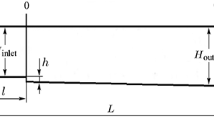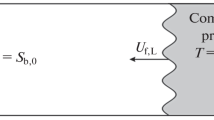Abstract
Numerical simulations are used to study the effect of the chemical composition of the combustible mixture on the development of the hydrodynamic instability of the flame front, its acceleration, and the possibility of transition to the detonation regime. The combustion of hydrogen-containing mixtures in confined spaces (channels) was considered. Calculations were performed within the framework of a two-dimensional hydrodynamic model for the combustion of premixed mixtures with account of viscosity, heat conduction, multicomponent diffusion, and chemical kinetics. It was demonstrated that the presence of an inert component and the deviation of the mixture composition from stoichiometry caused not only a quantitative but also a qualitative change in the character of burning of gaseous combustible mixtures.
Similar content being viewed by others
References
P. Urtiew and A. K. Oppenheim, Proc. R. Soc. London A 295, 13 (1966).
K. Oppenheim and R. I. Soloukhin, Am. Rev. Fluid Mech. 5, 31 (1973).
K. I. Shchelkin and Ya. K. Troshin, Combustion Gas Dynamics (Akad. Nauk SSSR, Moscow, 1963) [in Russian].
M. A. Nettleton, Gaseous Detonations: Their Nature, Effects and Control (Chapman and Hall, London, 1987; Mir, Moscow, 1989).
I. Brailovskty and G. I. Sivashinsky, Combust. Flame 122, 492 (2000).
M. A. Liberman, M. F. Ivanov, O. E. Peil, D. M. Valiev, and L.-E. Eriksson, Combust. Theory Model. 7, 653 (2003).
V. Bychkov, A. Petchenko, V. Akkerman, and L.-E. Eriksson, Phys. Rev. E 72, 046307–1 (2005).
V. N. Gamezo, E. S. Oran, and A. M. Khokhlov, in Proc. 41st Aerospace Sci. Meeting (AIAA, Reston, VA, 2003), p. 1317.
Ya. B. Zel’dovich, V. B. Librovich, G. M. Makhviladze, and G. I. Sivashinsky, Astron. Acta 15, 313 (1970).
Ya. B. Zel’dovich, Combust. Flame 39, 211 (1980).
M. A. Liberman, S. M. Golberg, V. V. Bychkov, and L.-E. Ericsson, Combust. Sci. Tech. 136, 221 (1998).
M. A. Liberman, G. I. Sivashinsky, D. M. Valiev, and L.-E. Ericsson, Int. J. T. Phenom. 8, 253 (2006).
V. A. Levin, V. V. Markov, T. A. Zhuravskaya, and S. F. Osinkin, Pulse Detonation Engines, Ed. by S. M. Frolov (Torus Press, Moscow, 2006), p. 235 [in Russian].
V. A. Gal’burt, M. F. Ivanov, and V. A. Petukhov, Khim. Fiz. 26(2), 46 (2007).
D. R. Stull and H. Prophet, Thermochemical Tables, 2nd ed. (Department of Commerce: Nat. Bureau of Standards, Washington, DC, 1971).
J. Warnatz, U. Maas, and R. W. Dibble, Combustion: Physical and Chemical Fundamentals, Modeling and Simulation, Experiments, Pollutant Formation (Springer, Berlin, New York, 2001; Fizmatlit, Moscow, 2003).
O. M. Belotserkovskii and Yu. M. Davydov, The Method of Large Particles in Gas Dynamics. Numerical Experiment (Nauka, Moscow, 1982) [in Russian].
M. A. Liberman, M. F. Ivanov, O. E. Peil, D. M. Valiev, and L.-E. Eriksson, Combust. Sci. Tech. 177, 151 (2005).
M. A. Liberman, M. F. Ivanov, D. M. Valiev, and L.-E. Eriksson, Combust. Sci. Tech. 178, 1613 (2006).
E. Hairer and G. Wanner, Solving Ordinary Differential Equations. 2. Stiff and Differential-Algebraic Problems (Springer, 1991; Mir, Moscow, 1999).
K. A. Kazakov and M. A. Liberman, Phys. Rev. Lett. 88, 064502–1 (2002).
P. Pelce and P. Clavin, J. Fluid Mech. 124, 219 (1982).
Ya. B. Zel’dovich, G. I. Barenblatt, V. B. Librovich, and G. M. Makhviladze, Mathematical Theory of Combustion and Explosion (Nauka, Moscow, 1980) [in Russian].
B. E. Gel’fand, O. E. Popov, and B. B. Chaivanov, Hydrogen: Parameters of Combustion and Explosion (Fizmatlit, Moscow, 2008) [in Russian].
L. E. Bollinger, M. C. Fong, and R. Edse, ARSJ 31, 588 (1961).
Author information
Authors and Affiliations
Corresponding author
Additional information
Original Russian Text © M.F. Ivanov, A.D. Kiverin, 2010, published in Khimicheskaya Fizika, 2010, Vol. 29, No. 2, pp. 48–54.
Rights and permissions
About this article
Cite this article
Ivanov, M.F., Kiverin, A.D. Effect of the composition of the combustible mixture on the development of flame front instability. Russ. J. Phys. Chem. B 4, 110–116 (2010). https://doi.org/10.1134/S1990793110010173
Received:
Published:
Issue Date:
DOI: https://doi.org/10.1134/S1990793110010173




